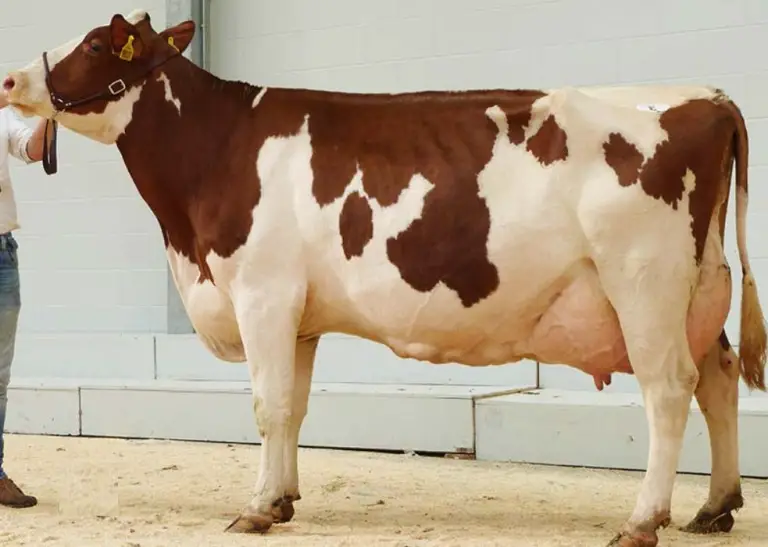No products in the cart.
Cow
Ayrshire Cows: Origin, Characteristics, Uses, And More Facts
Ayrshire milk is worldwide well-known for its rich flavor and texture. But have you known anything about the Ayrshire cows? This article will reveal information on this cow breed, its origin, its characteristics, and the reasons behind its excellent milk quality.
*This post may have affiliate links, which means I may receive commissions if you choose to purchase through links I provide (at no extra cost to you). As an Amazon Associate I earn from qualifying purchases. Please read my disclaimer for additional details.
Breed History: Where Did The Ayrshire Cow Originated?
Ayrshire cows (previously known as Dunlop, then Cunningham) were named after its place of origin, the County of Ayr in the south of Scotland. This cow breed resulted from cross-breeding between the native Scottish with several foreign species.
The native Scottish was known as a small size breed, ill-fed, and bad milkers. Not until 1750, this native breed was cross-bred with Teeswater and the Channel Islands – two species from the West Highland and the improved Shorthorn that were well-suited with the Ayr weather.
In 1814, the Highland Agricultural Society recognized the Ayrshire cow as an established breed. While early Ayrshires were black, their next generations were brown and mottled with improved milk production. This continuous stock improvement resulted in efficient dairy cows who could withstand the harsh climates and scarce forage of the Scottish Lowlands.
Ayrshire cows were first imported to America in 1822, especially in Connecticut and some parts of New England, where the weather was similar to its homeland. The growth of this cow breed was marked by the establishment of the American Ayrshire Breed Association in 1875 and the Approved Ayrshire Milk program for Ayrshire’s owners in the 1930s.
Nowadays, Ayrshires are raised in many states of North America, including New York and Pennsylvania. Besides, they are becoming popular in many countries like Russia, New Zealand, Great Britain, Africa, Australia, Europe, and South America.
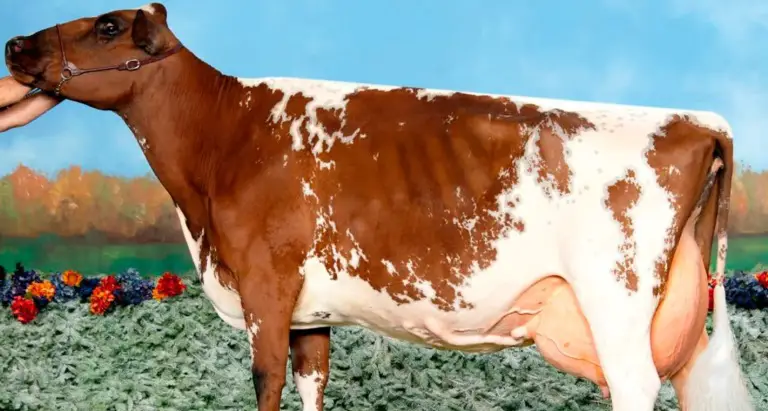
Characteristics Of Ayrshire Cattle
Physical appearance
Ayrshire cows are medium-sized cattle with an average weight of 1,200 pounds and a height of 50-53 inches at their maturity.
Early Ayrshires have wide and curved horns that can be up to 1 foot long or more like a breed’s hallmark, but most modern ones are dehorned as calves to reduce injuries to other cattle and their owners.
The modern Ayrshires have two primary colors – red and white, with the red spots varied from reddish-brown mahogany to light red. Some Ayrshires have only one color – all red or all white. Their color is similar to their two relatives Breyer Ayrshire and Beswick Ayrshire.
Besides, this cattle breed is also known for its excellent udder formation with no foot or leg issues.
Temperament
Ayrshire cattle are excellent foragers. Originated from the Scottish Lowlands, these animals are strong and can quickly adapt to many management systems and adverse local climates and rugged terrains.
Unlike some dairy breeds like the Holstein-Friesian, Ayrshires can survive under poor feeding and less fertile soil.
In addition, Ayrshire cattle have good temperament and behavior. They are least susceptible to attack by their fellows and least sensitive to group change.
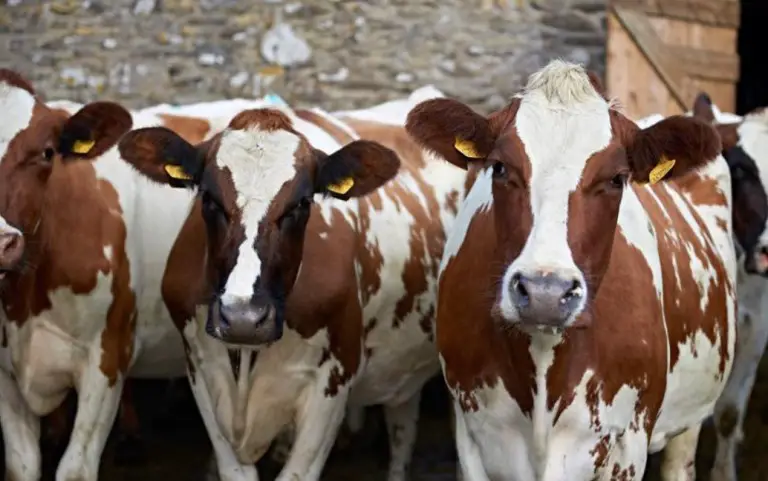
Ayrshire Cows Uses
Ayrshire cows are raised mainly for milk production. They have a low number of somatic cells, enabling them to convert grass into milk more efficiently.
Ayrshire milk is well-known as ‘the ideal drinking milk’ for humans. It is not excessively rich. Besides, it has a perfect fat/protein ratio with 4% fat and 8.8% non-fat solids (protein, casein). This milk is white with tiny yellow fat globules.
In a chain of premium stores in South Africa, over 70% of customers preferred Ayrshire milk over milk from other breeds like Jersey or Holstein. Nonetheless, the high milk fat percentage, protein, and kappa casein in Ayrshire milk make it an ideal ingredient for making cheese, ice cream, and yogurt.
Although this milk was recently replaced by Holstein milk, it is reviving again due to its high grass-to-milk conversion rate.
Besides milk production, Ayrshires can also be raised for beef. Their meat doesn’t contain yellow tallow, a rendered form of fat that would reduce their carcass value. Thus, an Ayrshire bull calf can be raised as steers.
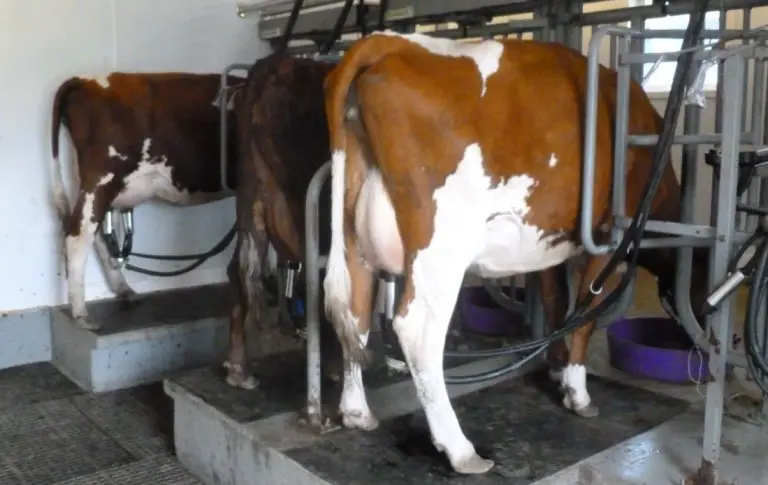
How much milk does an Ayrshire cow produce?
The average milk production of an average Ayrshire cow is approximately 12,000 pounds per year. But this number can be up to 20,000 pounds/year.
Ida, an Ayrshire female cow in the Latte Farms Betty, holds the world record for milk production. She produced 37,170 pounds of milk and 1,592 pounds of fat in 305 days.
Read more: How Long Do Cows Give Milk?
Ayrshire Cows Food & Health
Generally, Ayrshire cows are healthy with strong feet and legs and no genetic disease. The calves are robust, and the cows can calve easily. The Ayrshires can stay healthy after years of producing milk, while other breeds have fallen. In other words, when raising this medium-sized breed, you will lessen the budget spent for medical care, which is a strong plus for farm budgeting.
Ayrshire cows are preferred for their economic benefits and their extensive lifespan. If you are a farmer with limited budgeting, you can keep these cattle stay longer in their herd for extra milk production cycles while others have fallen.
Originated in the harsh nature of Scottish Lowlands, this cattle breed can survive well in all extreme local weather conditions, rugged terrains, or poor forage. It can also be well-adapted to all farming methods.
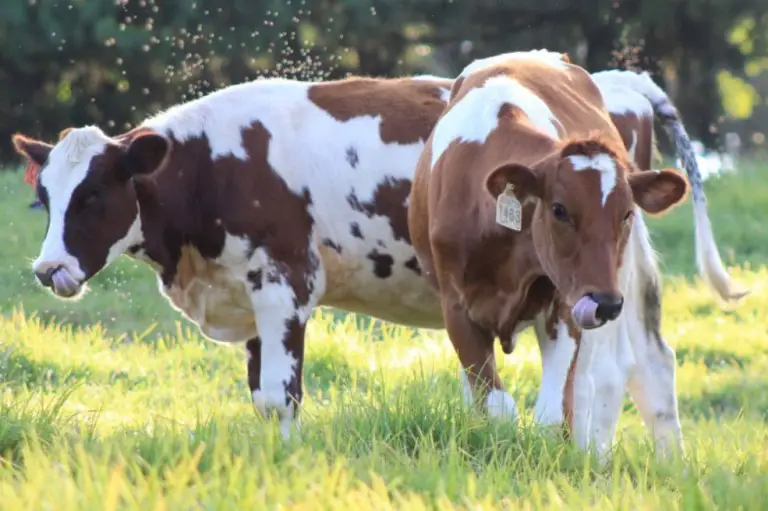
What do Ayrshire cows eat?
Ayrshire cows forage for food as their instinct. Their primary food source is the grass grown in the local area.
How long do Ayrshire cows live?
Ayrshire cows can live up to 20 years like other dairy cow breeds. However, they can stay healthy after a long period of milk production while others have serious health problems due to their aging process.
Read more: How long do Cows live?
Ayrshire Cows Price
The average cost of an Ayrshire cow is around $134,000. This cost also depends on her milk production, lactation status, age, and pregnancy status.
Pros And Cons Of Ayrshire Cattle
Pros
There are three advantages of Ayrshire cattle:
- They can provide a high quantity of milk with a high grass-to-milk conversion rate. The milk quality is ideal for premium marketplaces and can be converted to other dairy products like ice cream, cheese, butter.
- They are physically strong with minimal health issues and well-adapted to harsh weather conditions and farming methods.
- They can calve easily and have good longevity.
Cons
There are two disadvantages of the Ayrshire cattle:
- They produce less milk than the Holstein. An Ayrshire cow can only produce 12,000 pounds/year. Yet, a Holstein cow can provide 23,000 pounds of milk/year, which is around 74 pounds of milk per day.
- They have a strong personality, making it difficult to handle for farmers with little or no experience.
FAQs (Frequently Asked Questions)
1. What is the Ayrshire cow known for?
The Ayrshire cow is known for its ease of calving, hardiness, and high grass-to-milk conversion ratio.
2. Do Ayrshire cows have horns?
Although Ayrshire cows have horns, most are dehorned as calves to minimize injuries to other cattle and their owners.
Discover more: Lowline Angus Cattle: Growth Rate, Meat Quality, And More
Final Words
After reading the article on the Ayrshire cow breed, you have known that this breed is healthy and easy to raise with low feeding, low medical cost, and high profitability.
Although its milk quantity is now as much as its counterparts (the Holstein), its milk quality is highly praised as ‘ideal drinking milk’ and easy to convert into other dairy products.
